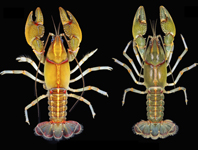Abstract
Insular bats are among the most vulnerable mammal species whose survival are threatened by several human-mediated factors, frequently paralleled by the paucity of information and lack of adequate management plans. Pipistrellus sturdeei is known only by the holotype collected from the remote Bonin Islands more than a hundred years ago and is declared to be extinct by the Japanese authorities. However, its taxonomic validity and collection locality is regarded ambiguous by some scholars. Here we report details about its collection circumstances and provide evidence that it morphologically differs from all other pipistrelles. We would like to raise attention on the species and the importance of a detailed study on its possible survival.
References
Abe, H., Ishii, N., Ito, T., Kaneko, Y., Maeda, K., Miura, S. & Yoneda, M. (2005) A guide to the mammals of Japan. Tokai University Press, Kanagawa, 206 pp. [in Japanese]
Conenna, I., Rocha, R., Russo, D. & Cabeza, M. (2017) Insular bats and research effort: a review of global patterns and priorities. Mammal Review, 47, 169–182.
https://doi.org/10.1111/mam.12090
Corbet, G.B. & Hill, J.E. (1992) The mammals of the Indomalayan Region: a systematic review. Natural History Museum Publications and Oxford University Press, New York, viii + 488 pp.
Fisher, D.O. & Blomberg, S.P. (2011a) Correlates of rediscovery and the detectability of extinction in mammals. Proceedings of the Royal Society London B, 278 (1708), 1090–1097. [for 2011]
https://doi.org/10.1098/rspb.2010.1579
Fisher, D.O. & Blomberg, S.P. (2011b) Inferring extinction of mammals from sighting records, threats, and biological traits. Conservation Biology, 26 (1), 57–67. [for 2012]
https://doi.org/10.1111/j.1523-1739.2011.01797.x
Fox, J. (2005) The R commander: a basic-statistics graphical user interface to R. Journal of Statistical Software, 14, 1–42.
https://doi.org/10.18637/jss.v014.i09
Fuller, E. (1988) Extinct birds. Facts on File Publications, New York, 256 pp.
Lê, S., Josse, J. & Husson, F. (2008) FactoMineR: An R Package for Multivariate Analysis. Journal of Statistical Software, 25, 1–18.
https://doi.org/10.18637/jss.v025.i01
Hasuo, Y. (1970) Land fauna. In: Tuyama, T. & Asami, S., (Eds.), The Nature in the Bonin Islands. Hirokawa Publishing Co., Tokyo, pp. 143–178. [in Japanese]
Hill, J.E. & Harrison, D.L. (1987) The baculum in the Vespertilioninae (Chiroptera: Vespertilionidae) with a systematic review, a synopsis of Pipistrellus and Eptesicus, and the description of a new genus and subgenus. Bulletin of the British Museum (Natural History), Zoology, 52, 225–305.
Lopez-Baucells, A. (2019) Pipistrellus sturdeei. In: Wilson, D.E. & Mittenmeier, R.A. (Eds.), Handbook of the Mammals of the World. Vol. 9. Bats. Lynx Edicions, Barcelona, pp. 778–779.
MacPhee, R.D.E. & Flemming, C. (1999) Requiem aeternam: the last five hundred years of mammalian species extinctions. In: MacPhee, R.D.E. (Ed.), Extinctions in near-time. Kluwer Academic/Plenum, New York, pp. 333–371.
https://doi.org/10.1007/978-1-4757-5202-1_13
Maeda, K. (2001) Natural history of Japanese bats. University of Tokyo Press, Tokyo, 203 pp. [in Japanese]
Maeda, K. (2008) Pipistrellus sturdeei. IUCN Red List of Threatened Species 2008.
https://doi.org/10.2305/IUCN.UK.2008.RLTS.T17365A7010947.en
Ministry of the Environment (2019) Red List 2019. Available from: https://ikilog.biodic.go.jp/Rdb/booklist (accessed 8 January 2020)
Ohdachi, S.D., Ishibashi, Y., Iwasa, M.A., Fukui, D. & Saitoh, T. (2015) The wild mammals of Japan. 2nd Edition. Shoukadoh Book Sellers, Kyoto, 506 pp.
R Core Team (2018) R: A language and environment for statistical computing. R Foundation for Statistical Computing, Vienna. Available from: http://www.R-project.org (accessed 24 February 2020)
Saitoh, T., Kaji, K., Izawa, M. & Yamada, F. (2015) Conservation and management of terrestrial mammals in Japan: its organizational system and practices. Therya, 6 (1), 139–153.
https://doi.org/10.12933/therya-15-239
Seebohm, H. (1890) On the Birds of the Bonin Islands. Ibis, Series 6, 2, 95–108.
https://doi.org/10.1111/j.1474-919X.1890.tb06470.x
Shibuya, J. (1929) On the Pyralidae from the Bonin Islands. Insecta Matsumurana, 3, 111–114.
Simmons, N.B. (2005) Order Chiroptera. In: Wilson, D.E. & Reeder, D.M. (Eds.), Mammal Species of the World. A Taxonomic and Geographic Reference. 3rd Edition. The Johns Hopkins University Press, Baltimore, pp. 312–529.
Tada, M. (1996) Kyoukaisenjou no Doubutsu-tachi. Shogakukan Inc., Tokyo, 285 pp. [in Japanese]
Tate, G.H.H. (1942) Results of the Archbold expeditions 47. Review of the vespertilionine bats, with special attention to genera and species of the Archbold collections. Bulletin of the American Museum of Natural History, 80, 221–297.
Thomas, O. (1915) On bats of the genera Nyctalus, Tylonycteris, and Pipistrellus. The annals and magazine of natural history, Series 8, 15 (86), 225–232.
https://doi.org/10.1080/00222931508693632
Waterhouse, C.O. & Gahan, C.J. (1890) Observations on some Coleoptera from the Bonin Islands. The annals and magazine of natural history, Series 6, 5, 169–170.
https://doi.org/10.1080/00222939009460802
Woinarski, J. (2018) A bat’s end—The Christmas Island Pipistrelle and extinction in Australia. CSIRO Publishing, Clayton South, 280 pp.
https://doi.org/10.1071/9781486308644

